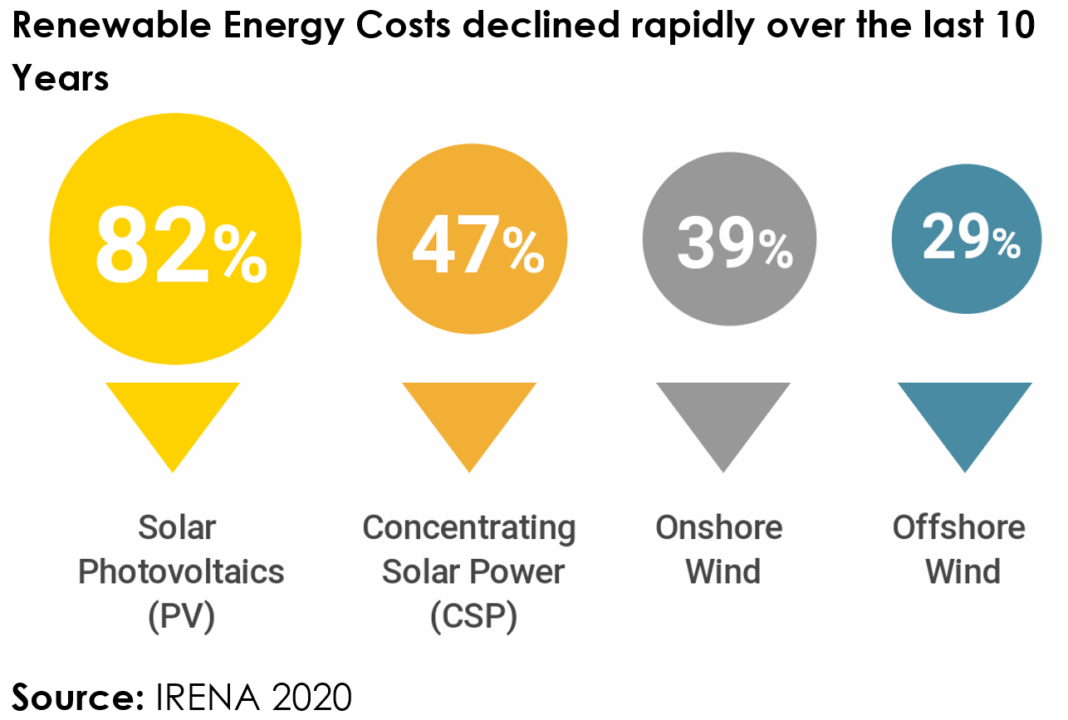The push for renewable energy to dominate the future energy architecture on a global level, to supplement and eventually substitute the more polluting traditional energy sources known as fossil fuels, have always been met with stiff opposition and some challenges. In spite of the drawbacks which includes intermittency, costs, unfavorable politics and regulation among others, renewables such as solar and wind power are bracing the odds to cement its position as the most clean, economical and sustainable energy option.
Although for decades, efforts by the renewable energy firms and advocates have been thwarted by fossil fuel companies and their allies, it appears renewables now have the clout to fight back at fossil fuels which remain as the main energy source for the world’s economic engine. Jeff McMahon Senior Contributor at Forbes describes it as “a pitched battle” because both industries are forcing new megawatts (MW) into a market that’s shrinking.
A New Twist
Recent energy sector data seem to present a new twist to this long standing battle between fossil fuels and renewable fuels, in terms of consumption, costs, and investments.
-
- Consumption: A newly released figure from the Energy Information Administration (EIA) indicates that Americans achieved a key milestone in 2019 in its energy consumption, with recent forecasts pointing to renewables eclipsing coal as an electricity source in 2020. That the use of coal-based energy fell by 15 percent, while renewable energy sources such as from solar and wind grew by 1 percent. The EIA report suggest that over the last decade, coal use for electricity generation has been in rapid decline, falling to its lowest in 42 years in 2019, due the emergence of cheaper alternatives such as plentiful natural gas and falling costs for solar and wind power. This is a clear manifestation that more energy was consumed from renewable sources than from burning coal. According to the New York writer Oliver Milman, on May 21, the year hits its 100th day in which renewables have been used more heavily than coal. He indicates that the renewables are overtaking coal the first time since at least 1885, a year when America’s first skyscraper was built in Chicago. According to him, the ongoing collapse of coal would have been nearly unthinkable a decade ago, when coal made up for close to 50 percent of America’s electricity generation. And that proportion may fall to under 20 percent this year, with analysts predicting a further halving within the coming decade. In Milman’s view, the rapid slump since then has not been reversed despite the efforts of the Trump Administration, which has dismantled a key Barrack Obama-era climate rule to reduce emissions from coal plants and eased requirements that prevent coal operations discharging mercury into the atmosphere and waste into streams.
- Cost: Aside increased consumption, a 2019 data recently released by the International Renewable Energy Agency (IRENA) shows that newly installed renewable power capacity increasingly costs less than the cheapest power generation options based on fossil fuels. According to the IRENA, more than 50 percent of the renewable capacity added in 2019 achieved lower electricity costs than new coal. Auction and Power Purchase Agreements (PPAs) results shows an accelerating and favorable cost trends for renewables with new solar and wind projects undercutting the cheapest of existing coal-fired plants.
According to IRENA, solar and wind power costs have continued to fall, complementing the more mature bioenergy, geothermal and hydropower technologies, thanks to improved “technologies, economies of scale, increasingly competitive supply chains and growing developer experience.
Solar photovoltaics (PV) reveals the sharpest cost decline over 2010-2019 at 82 percent, followed by concentrating solar power (CSP) at 47 percent, onshore wind at 40 percent, and offshore wind at 29 percent. Also, electricity costs from utility-scale solar PV dropped 13 percent year-on-year, reaching nearly 7 cents (US$0.068) per kilowatt-hour (kWh) in 2019. Onshore and offshore wind both fell about 9 percent year-on-year, reaching US$0.053/kWh and US$0.115/kWh, respectively, for newly commissioned projects. Costs for CSP, still the least-developed among solar and wind technologies, fell 1 percent to US$0.182/kWh.

Additionally, IRENA indicates that solar PV prices based on competitive procurement could average close to 4 cents (US$0.039) per kilowatt-hour for projects commissioned in 2021, down 42 percent compared to 2019, and more than one-fifth less than the cheapest fossil-fuel competitor like coal-fired plants. IRENA noted that record-low auction prices for solar PV in Abu Dhabi and Dubai (UAE), Chile, Ethiopia, Mexico, Peru and Saudi Arabia confirm that values as low as 3 cents/kWh are already possible.
For instance, Africanews reports that the Al Dhafra project in Abu Dhabi is set to be the largest solar plant in the world, with the new plant having received the most cost-competitive tariff for solar PV energy ever recorded, at 1.35 cents (US$0.0135) per kilowatt-hour on a levelised electricity cost (LEC) basis. The new set tariff is estimated to be roughly 44 percent lower than the one approved three years ago at Noor Abu Dhabi, the world’s largest 1.2 gigawatt (GW) solar plant.
The accelerating trend of cheaper solar photovoltaic (PV) and onshore wind power is putting more economic pressure on coal plants, and reinforcing the case to phase-out coal entirely. In the estimation of IRENA, as much as 1,200 GW of existing global coal-fired generation capacity could cost more to operate next year than new utility-scale solar PV.
- Investment: While renewable energy is growing cheaper, offering huge potential to stimulate the global economy, investment in renewables is equally presenting itself as stable, cost-effective and attractive; offering consistent and predictable returns.
Matthew DiLallo a Senior Energy and Materials Specialist with The Motley Fool, sees many companies benefiting from the expected growth of the renewable energy industry in the coming years. He presented Brookfield Renewable Partners, Clearway Energy, and NextEra Energy (all trading on the New York Stock Exchange) as three companies that stands out relative to others in the industry.
Matthew described all the three companies as routine outperformers. While Brookfield Renewable Partners has generated market-crushing total returns since its inception. It has also beaten the market year to date as well as over the past one, three, and five-year periods. Clearway Energy is also described as having the wind at its back these days. It estimates its cash-flow to soar 22 percent this year, powered by several acquisitions last year. Like Brookfield Renewable, electric utility NextEra Energy’s performance trend appears likely to continue in the coming years. The company expects that its earnings will grow by at least 6-8 percent per annum through 2022. Meanwhile, it anticipates that it can increase its 2.2 percent yielding dividend by at least a 10 percent annual pace during that time-frame.
The consumption, cost, and investment data presented in the comprehensive study from the International Renewable Energy Agency (IRENA), the Energy Information Administration (EIA), the MotleyFool among others, goes to show how decisively the tables have turned in favour of renewables.
A Road Map to 2050
According to the 2019 edition of IRENA’s, Global energy transformation: A roadmap to 2050, aside the pairing electrification with renewables getting cheaper than fossil fuel-based alternatives, it is lowering local air pollution and increasing health benefits; resulting in positive socio-economic benefits and presenting it as a key enabler to build a connected and digitalized economy and society. It suggests that electrification when paired with renewables, goes hand-in-hand with energy efficiency, resulting in lower overall energy demand.
In the estimation of IRENA, by 2050 electricity could become the central energy carrier, growing from a 20 percent share of final consumption to an almost 50 percent share, and as a result, gross electricity consumption would more than double. Renewable power will be able to provide the bulk of global power demand (86%) driven by over 1 billion electric vehicles, increased use of electricity for heat and the emergence of renewable hydrogen. Overall, renewable energy would supply two-thirds of final energy.
The body concludes that for every US$1 spent for the energy transition, there would be a payoff of between US$3 and US$7. In cumulative terms over the period to 2050, the payoff would be between US$65 trillion and US$160 trillion. IRENA is of the view that the energy transition requires fewer overall subsidies, as total energy sector subsidies can be reduced by US$10 trillion over the period. And that, the focus of subsidies will need to change progressively, however; away from power and fossil fuels and into energy efficiency technologies and solutions needed to decarbonize the industry and transport sectors.
In terms of additional investment, IRENA suggest that the level of additional investments required to set the world on a more climate-friendly path above current plans and polices is US$15 trillion by 2050. Though a significant sum, IRENA sees it as one that decreased by over 40 percent compared to the previous analysis due in large part to rapidly falling renewable energy costs as well as opportunities to electrify transport and other end-uses. Overall, total investment in the energy system would need to reach US$110 trillion by 2050, or around 2 percent of average annual gross domestic product (GDP) over the period. And in relation to jobs, IRENA claims that it would grow to reach 42 million globally by 2050, four times their current level, through the increased focus of investments on renewables. Energy efficiency measures would create 21 million and system flexibility 15 million additional jobs.
>>>The writer has over 23 years of experience in the technical and management areas of Oil and Gas Management, Banking and Finance, and Mechanical Engineering; working in both the Gold Mining and Oil sector. He is currently working as an Oil Trader, Consultant, and Policy Analyst in the global energy sector. He serves as a resource to many global energy research firms, including Argus Media and CNBC Africa. Email: [email protected]










